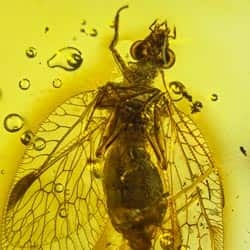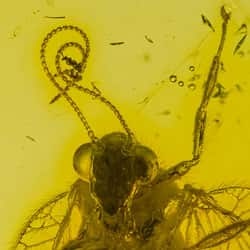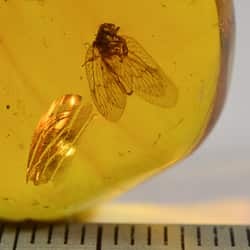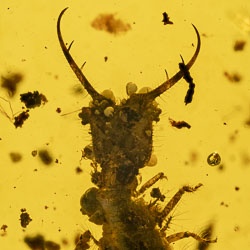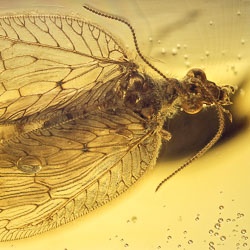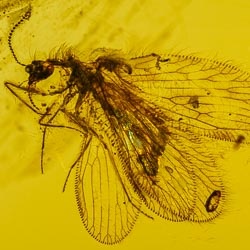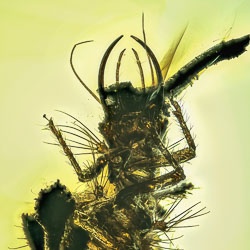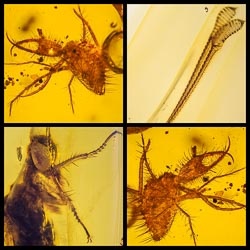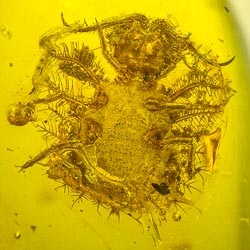Filters
Neuroptera Hemerobiidae - Astonishing Brown Lacewings AL029
Genuine Dominican Amber Fossil
Neuroptera Hemerobiidae (Brown Lacewings)
Hemerobiidae are brownish, soft bodied insects with long filiform antennae and finely netted wings.
They are weak fliers. Both larvae and adults are voracious predators of small insects and mites.
Very High Quality Specimen
Complete - Totally Covered by the Amber - Centered
Perfectly Displayed on Crystal Clear Amber Piece
18.3 x 7.6 x 7.4mm - 3.64Ct
[widgetkit id="964" name="AL029 Neuroptera Hemerobiidae - Brown Lacewings"]
Neuroptera Hemerobiidae Brown Lacewing AF01-132
Museum Quality Specimen - Highly Collectible
Spectacular Brown Lacewing Neuroptera Hemerobiidae
Amazing Wings and Body Details
Very well Displayed on Clear & Solid Amber Piece
[widgetkit id="152" name="AF01-132 Heteroptera Hemerobidae Lacewing"]
Neuroptera Hemerobiidae Brown Lacewing V1310
Stunning Brown Lacewing
Neuroptera Hemerobiidae
Neuropteran are Extremely Rare on Dominican Amber
Few Specimens Only was Found on the Past years
Very Rare Specimen - Highly Collectible
Miss a small part of a Wing - A Fracture Surround the Inclusion
Superb Details Very Sharp Live Like
25.8 x 9.7 x 3.9mm - 0.62g
[widgetkit id="89" name="V1310 Brown Lacewing Neuroptera Hemerobiidae"]
Neuroptera Mantispidae Very Exclusive Specimen AF01-196
Genuine Dominican Amber fossil
Neuroptera Mantispidae (Mantidfly)
One of The Rarest Inclusion on Dominican Amber
Mantispidae are Characterised by Their Very Strong Raptorial Forelegs, Large Eyes and Elongation of the Pronotum Behind the forelegs.
On Dominican Amber only 2 specimens has been discribed: Feroseta Priscus (Poinard 2006)& Dicromantispa Moronei (Grimaldi - Engel 2007)
This Absolutely Complete Specimen is by far the Nicest one Collected to Time
Inclusion is Displayed in a Beautiful Attitude & Totally Covered by the Amber with no Part Reaching The Surface
29.6 x 21.6 x 7.9mm - 2.8g
[widgetkit id="744" name="AF01-196 Neuroptera Mantispidae"]
Neuroptera Hemerobiidae Brown Lacewing AF01-127
Super Nice Brown Lacewing
Heteroptera Hemerobidae
A Must Have in All Serious Collections
31.2 x 25.4 x 12.4mm - 5.8g
[widgetkit id="278" name="AF01-127 Brown Lacewing"]
Neuroptera Ascalaphidae - Owlfly Larva - Burmese Specimen VB0101
Authentic Amber Fossil From Myanmar (Burma)
Burmese Amber is more than 100M years old, this is one of the oldest Amber.
Most of Specimens present on Burmese Amber are Extinct.
Super Nice & Rare Specimen of Owlfly Larva (Neuroptera Ascalaphidae)
20.0 x 12.5 x 6.2mm - 5.3Ct
Specimen Collected Personaly in Burma During our 2019 February trip
[widgetkit id="671" name="VB0101 Owlfly Larva"]
Neuroptera Ascalaphidae - Owlfly Larva Ultra Rare V1618
Extremely Rare Neuroptera Specimen
Super Exclusive Owlfly Larva (Ascalaphidae)
Beautiful Specimen with Entire Body and Very Well Detailed Bristles
A Must Have Piece in All Serious Collections !!!!
[widgetkit id="147"]
Museum Quality Brown Lacewing & Very Nice Flower Tumbling Beetle AL027
Genuine Dominican Amber
Neuroptera Hemerobiidae & Coleoptera Mordellidae
Museum Quality Brown Lacewing & Very Sharp Flower Tumbling Beetle
Both Inclusions are Absolutely Complete & Totally Covered by the Amber
16.8 x 12.1 x 10.4mm - 7.46Ct
[widgetkit id="1072" name="AL027 Neuroptera Hemerobiidae Brown Lacewing - Coleoptera Mordellidae Flower Tumbling Beetle"]
Neuroptera Hemerobiidae Burmese Brown Lacewing VB0105
Authentic Amber Fossil From Myanmar (Burma)
Burmese Amber is more than 100M years old, this is one of the oldest Amber.
Most of Specimens present on Burmese Amber are Extinct.
This Beautiful Brown Lacewing (Heteroptera Hemerobiidae) is in perfect condition (for her age....LOL), Very well displayed on a amazing attitude with a lot of stunning details.
14.8 x 10.1 x 3.6mm - 1.55Ct
Specimen Collected Personaly in Burma During our 2019 February trip
[widgetkit id="670" name="VB0105 Brown Lacewing"]
Neuroptera Chrysopidae - Unique Green Lacewing Larva AF01-231
Genuine Dominican Amber Fossil Inclusion
Incredible, never seen before, Museum Quality, Larva of Green Lacewings – Neuroptera Chrysopidae carrying debris, perfectly displayed in a transparent clear amber gemstone.
Larvae of Chrysopidae are voracious predators, they use their sickle shaped jaws to pierce their prey, inject salivary secretions and then absorb the internal fluids. This beautiful specimen, totally covered by amber, belong to the lineage of Green Lacewings that carry a debris packet, which provides a camouflage to prevents visual and tactile detention from both predators and prey.
The condition of this Specimen is Really Exceptional, all details are Highly Visible.
A Must Have Master Piece for Any Serious Collection
29.5 x 17.4 x 5.9mm - 1.72g
[widgetkit id="929" name="AF01-231 Neuroptera Chrysopidae Green Lacewing Larva"]
Larva & Adult Neuroptera Myrmeleontidae (Antlion) AF01-176
Genuine Dominican Amber Fossils
Fantastic World Class Museum Inclusions
LARVA & ADULT ANTLIONS (NEUROPTERA PLANIPENNIA MYRMELEONTIDAE)
Adult antlions are medium to large size insects. They resemble damselflies (Order Odonata) but differ in being soft bodied, in having clubbed antennae as long as the head and the thorax combined, and a very complex wing venation. Also, unlike damselflies, when at rest, antlions held the wings rooflike above the body. While odonates are strong and speedy diurnal fliers, antlions are very feeble fliers and have nocturnal habits. Adult antlions have a short life span and little is known about their behaviour. They mate in the summer and the female lays her eggs in sandy soil. Antlions undergo a complete metamorphosis.
Larvae have a grotesque, robust, fusiform grey-brown body, bearing three pairs of walking legs and a slender neck. Their small trapezoidal, flattened head bear an enormous pair of sicklelike jaws (mandibles), each one with three pairs of sharp, teethlike projections. Head, body and appendage surface are covered with many long bristles oriented laterally. They prey on ants and other ground insects. Some species construct conical pits in sandy soil and wait for the prey at the bottom of the trap, leaving only the sicklelike jaws protrude from the sand. Catching behaviour comprises sand tossing, prey beating, grasping and prey submersion. After consuming all the contents of the prey antlions larvae flick out of the pit the lifeless, dry carcass of the prey. Larvae have an unusually long-life cycle that may take two or three years. When is full grown, at the end of the third instar, the larva pupates in a spherical cocoon made of sand and silk. One month later an adult antlion emerges from the pupal cocoon.
* * * * *
Antlions are super rare in Dominican amber; only a single species, Porrerus Dominicanus has been described by Poinar and Stange* The original description was emended by Engel and Grimaldi ** who also reported two additional specimens and described a larva of Myrmeleontidae tentatively assigned to Porrerus Dominicanus.
* * * * *
This adult specimen was trapped in a clear amber stone while at rest, with the wings held rooflike above the body and is very well preserved. It differs from Porrerus Dominicanus in having longer antennae and hairy wings.
Length of antennae +/-5.9mm. Length of body +/-5.6mm. Amber piece 19.7 x 7.6 x 6.4mm - 0.652g
The larva is well preserved along with a spider and a nymph of Homopteran. Its mandibles are much longer than the head. Head, body and legs are densely covered with elongate rigid black bristles.
Amber piece 32.7 x 17.1 x 10.6mm - 3.258g
* Poinar, G.O. Jr. and L.A. Stange, A new antlion from Dominican amber (Neuroptera: Myrmeleontidae). Experientia, 1996, 52(4): 383–386.
** Michael S. Engel and David A. Grimaldi, The Neuropterid Fauna of Dominican and Mexican Amber (Neuropterida: Megaloptera, Neuroptera). American Museum Novitates, 2007, 1-58.
[widgetkit id="29" name="AF01-176 Larva & Adult Antlions"]
Feather and larva of Neuroptera V1499
Hyper Rare Inclusion on Dominican Amber
Super Nice Bristle Feathers well Displayed
Specimen Also Contains a SUPER RARE & unusual Larva of Neuroptera
A Must Have in all Serious Collections!!!
13.7 x 12.6 x 7.5mm - 0.7g
[widgetkit id="67" name="V1499 Dominican Amber Fossil Feather Inclusion and larva of Neuroptera"]
Neuroptera Ascalaphidae - Very Unique OwlFly Larva AL058
Genuine Dominican Amber
Neuroptera Ascalaphidae (Owlfly Larva)
Larvae of OwlFly are ambush predators on other insects and lie on the ground, often covered by debris, waiting for a prey.
They are characterized by the depressed large head with very elongate, three toothed mandibles, all thoracic and abdominal segments bear extended prominent segments with plumose setae.
This extraordinary specimen very well displayed on clear amber piece with mandibles wide open was trapped by amber while waiting for its prey.
37.1 x 20.3 x 8.2mm - 3.44g
[widgetkit id="963" name="AL058 Neuroptera Ascalaphidae - OwlFly Larva"]

